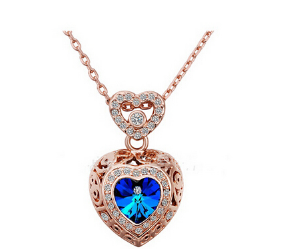Silver is a valuable metal. It’s delegated one of the Metals of Antiquity: metals that people distinguished and utilized in ancient occasions. The significant utilization of silver, other than being utilized for coinage all through world history, was in the production of gems and other general-use things. This is as yet the case today. Silver is ideal for neckbands, wristbands, sleeve buttons, belt clasps, and body gems. It is ideal for fine gems, frill, and flatware. The Hardness of Silver, Because of the delicate quality of unadulterated silver (2.5 to 3 on the Mohs Hardness scale) it is alloyed with copper. In adornments, real silver involves 92.5% silver and 7.5% copper. From the above description, we can easily know that it is not so easy to choose the material and to make it like a jewel. Among all the parts the Heart of the Ocean jewels is very much important for the buyers and producers.

The Pros and Cons of Using Silver for Jewelry Making
Stars: Adornments craftspeople love silver in the light of the fact that the material is delicate, pliant (effectively crushed), and bendable (handily extended). Silver is exceptionally intelligent (it used to be utilized to back mirrors, however, this is currently done utilizing aluminum) Silver can be cleaned to a brilliant sheen. It is economical contrasted with gold and platinum. Silver has great antibacterial properties for things like cutlery. Silver is solid and has a more drawn out life expectancy contrasted with different metals and outfit adornments. Cons: The delicateness of silver can likewise be a drawback – it might scratch and curve under dull day by day wear. Authentic silver adornments will discolor – which means it might take on a dark or green shade. Silver should be cleaned consistently to keep up its glimmer. Silver is touchy to acids and consumption and general synthetic substances. A few people are susceptible to silver because of its copper content.
As like the silver-gold is another majority using material
Unadulterated Gold is a splendid ruddy yellow valuable metal appraised in Karats (k). It is like silver in that it’s one of the Metals of Antiquity and was utilized for making coins, gems, and even printed as circling money (think Gold Standard as financial strategy pre-1971). The world utilization of new gold comprises half in gems, 40% in speculations, and 10% in industry. The Hardness of Gold, Unadulterated Gold (24k) is delicate and evaluated 2.5 to 3 on the Mohs Hardness scale and thusly it’s uncommon for it is utilized in its unadulterated structure for gems. Gold is alloyed with copper, silver, zinc, nickel, or palladium to deliver a harder material for the adornments exchange. Ordinary gold adornments are generally 14k gold, 16k gold, 18k gold, and 21k gold. In the Alloy cycle, Yellow, White, Rose and Green Gold can be delivered. Much like red lipstick – there is a tone or tint for everybody. For example, Rose gold is warming, and along these lines supported by those with paler skin. In any of its varieties, gold is a mainstream decision for wedding rings, rings, studs, armbands, and accessories because of its steadiness and life span. The Pros and Cons of Using Gold for Jewelry Making, Aces: Gold is probably the best metal utilized for adornments – generally the decision for wedding rings. Gold is one of the most pliable (effectively crushed) and flexible (handily extended) metals, making it simple to work with. Gold is impervious to most acids. Unadulterated gold won’t discolor, anyway 14k, 16k, 18k will do, yet considerably less so than Silver and throughout quite a while. Gold is less allergenic than silver, Cons: More valuable and along these lines more costly than Silver. Gold adornments can become scratched when worn consistently. The presence of nickel may not be appropriate for metal sensitivity victims.

